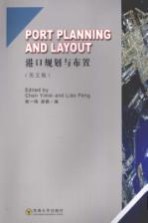
- 作 者:陈一梅,廖鹏编著
- 出 版 社:南京:东南大学出版社
- 出版年份:2009
- ISBN:9787564118969
- 标注页数:214 页
- PDF页数:223 页
请阅读订购服务说明与试读!
订购服务说明
1、本站所有的书默认都是PDF格式,该格式图书只能阅读和打印,不能再次编辑。
2、除分上下册或者多册的情况下,一般PDF页数一定要大于标注页数才建议下单购买。【本资源223 ≥214页】
图书下载及付费说明
1、所有的电子图书为PDF格式,支持电脑、手机、平板等各类电子设备阅读;可以任意拷贝文件到不同的阅读设备里进行阅读。
2、电子图书在提交订单后一般半小时内处理完成,最晚48小时内处理完成。(非工作日购买会延迟)
3、所有的电子图书都是原书直接扫描方式制作而成。
1 INTRODUCTION 1
1.1 The important role of modern ports 1
1.2 Port and its main components 2
1.3 Functions of modern ports 4
1.4 Classification of Ports 4
1.5 General information on port development 6
2 PORT OPERATION AND SHIPS 9
2.1 Cargoes 9
2.1.1 Classification of cargoes 9
2.1.2 Workings of cargoes inside the ports 11
2 2 Port hinterland and port throughput 12
2.2.1 Port hinterland and foreland 12
2.2.2 Port throughput 15
2 3 Forecast of port throughput 18
2.3.1 Introduction 18
2.3.2 Delphi Forecasting 20
2.3.3 Time series forecasting 22
2.3.4 Grey Prediction 25
2.4 Ships 27
2.4.1 Introduction 27
2.4.2 Shipboard measurement 28
2.4.3 Ship types 30
2.4.4 The development of maritime ship 36
2.4.5 Shipping services and networks 38
3 INVESTIGATION AND ANALYSIS FOR PORT PLANNING 40
3.1 Meteorological conditions 40
3.1.1 Wind 40
3.1.2 Rain and Fog 42
3.1.3 Ice 43
3.2 Oceanographic conditions 44
3.2.1 Tide 44
3.2.2 Waves 45
3.2.3 Currents 49
3.3 Estuary conditions 51
4 TERMINAL AND LAYOUT OF QUAYSIDE 53
4.1 Classification of terminals 53
4.1.1 By the function 53
4.1.2 By the layout 54
4.2 Scale of terminals 57
4.3 Determination of the optimum berth number 62
4.3.1 The calculation of optimum berth number 63
4.3.2 The application of queuing theory 64
4.4 Some suggestions for port operation management 70
4.4.1 Berth group 70
4.4.2 Handling productivity 71
4.4.3 The timing for increasing port capacity 72
4.5 Determination of berth scale 73
4.6 Typical layout for general cargo terminal 74
4.7 Typical layout for container terminal 77
4.7.1 Layout for container terminal water area 77
4.7.2 Layout for container terminal land area 78
4.8 Typical layout for dry bulk terminal 84
4.9 Typical layout for Ro/Ro berth 87
4.10 Typical layout for oil terminal 92
4.11 Typical layout for LPG/LNG terminal 94
4.12 Determination of berth surface elevation 97
5 HARBOR AND BREAKWATER 99
5.1 Introduction 99
5.2 Water depth 99
5.2.1 Components of water depth clearance and determinants 100
5.2.2 Water depth in berthing area 102
5.2.3 Water depth in approach channel 103
5.3 Channels 104
5.3.1 Channel Alignment 104
5.3.2 Channel width 105
5.4 Anchorage area and turning area 107
5.5 Standards for harbor tranquility 108
5.6 Layout of breakwater 110
5.7 Aids to navigation 113
6 LANDSIDE FACILITIES 114
6.1 Port railway 114
6.2 Road 118
6.3 Other facilities of port 120
7 PORT DEVELOPMENT PLANNING 124
7.1 Port planning process 124
7.1.1 Primary planning 124
7.1.2 The port distribution planning 126
7.1.3 The general port planning 126
7.1.4 The port area planning 127
7.2 Port demand forecasting 128
7.3 Port site selection 132
7.3.1 The port location 132
7.3.2 The basic types of the port arrangement 133
7.3.3 The basic requirement for the port site selection 135
7.3.4 The port area and the urban area 136
7.4 Port zoning 138
7.4.1 Port zoning strategy 139
7.4.2 Port zoning procedure 141
7.5 Port financial evaluation 142
8 PORT ENVIRONMENT ASSESSMENT AND PROTECTION 147
8.1 General introduction 147
8.2 Port environmental impact assessment 148
8.2.1 EIA of port construction projects 148
8.2.2 Environmental impact assessment of port planning 150
8.3 Environmental protection of domain coast 152
8.3.1 Domain coast environmental protection 152
8.3.2 Ecological environment protection 154
9 CHARACTERISTICS OF INLAND RIVER PORTS 156
9.1 Introduction 156
9.2 Site selection 157
9.3 Terminals facilities 161
9.4 Layout of Inland River Port 165
9.4.1 Terminal surface and bottom elevation 166
9.4.2 Layout of the berth line 167
Appendix A Introduction to EDI 169
Appendix B A Note on Queuing Theory 176
Appendix C Logistics and Route Selection 184
Appendix D Vessel Arrival and Berthing Time Distribution 189
Appendix E National Plan for Coastal Port 192
Appendix F Port of New York and New Jersey 198
Appendix G Special Economic Zone,Free Trade Zone and Free Port 204
References 213
